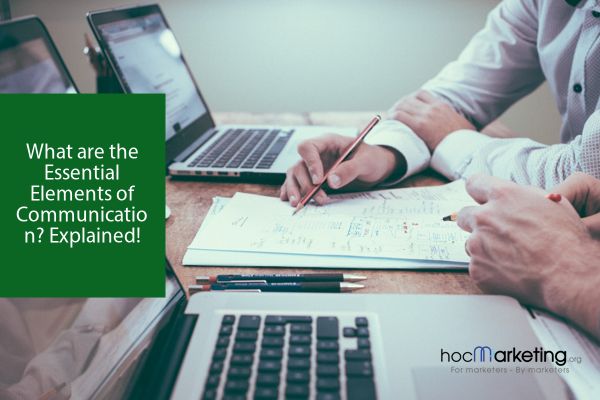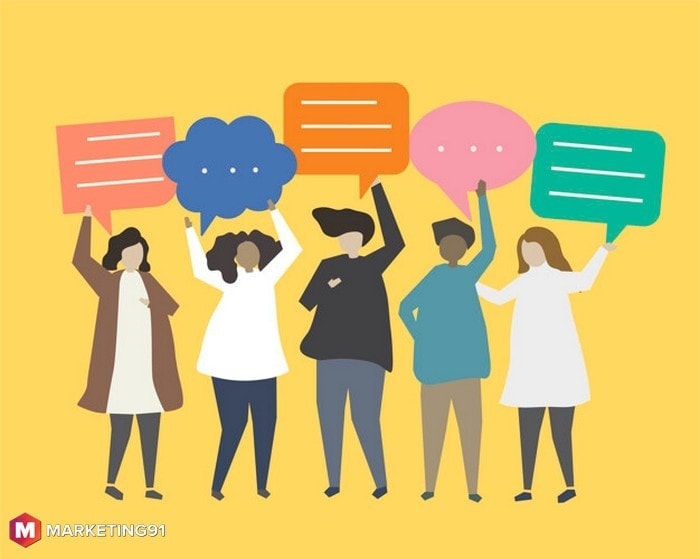
What are the Essential Elements of Communication? Explained!

Learn the importance of communication and its elements with our comprehensive guide Discover the functions, nature, features, and roles of communication while exploring its advantages Start improving your communication skills today!
Communication is a way by which meaningful messages can be conveyed across people to convey ideas. Any kind of medium may be used by communication to convey the message.
What is Communication?
The act of communication involves the exchange and comprehension of information. It is a dynamic process that is constantly evolving and cannot be easily defined. This is due to the fact that the process is influenced by various factors such as feedback, perspective, and other relevant changes that have an impact on the current situation. For instance, when commuting to work, your process of communication changes as your perspective shifts with each interaction you have with different individuals along the way.
Comprehending written and spoken language is an essential aspect of communication. To understand means to interpret or grasp the meaning behind the words. For instance, watching a movie with sound and explanation provides a clearer understanding than watching a silent movie. The final component of communication is sharing, which refers to engaging in an activity with one or more individuals.
Thus, communication is the combination of various elements that work together to create a clear, informed, and informative exchange of information. Its purpose is to transmit messages, share ideas, and communicate relevant thoughts to a recipient or group of recipients.
Importance to Communicate Effectively
Communication is essential for the functioning of the world. Its importance cannot be overstated in our daily lives. Without it, we would be stuck in the primitive times of our Neanderthal ancestors. In every aspect of our lives, from our homes to our workplaces, communication is omnipresent. We communicate through various forms like music, speeches, gestures, and handshakes without even realizing it. Communication makes expressing our thoughts easier and helps us understand the viewpoints of others.
Without communication, the process of learning would grind to a halt, as teaching relies on the use of text, images, sound, or sign language. Ideas and thoughts cannot be exchanged without communication, leading to unsustainable businesses and individuals unable to thrive.
Elements of Communication Skills
It is essential to understand the vital components of communication to understand the process of communicating clearly.
Following are eight different components of communication
1. Source
The originator of a message is known as the source. This individual is responsible for initiating and transmitting the message to the receiver. In a conversational setting, the person speaking to a group can be considered the source of the discourse. The message is conveyed through both verbal and non-verbal communication methods employed by the source.
The transmission of information can involve both written and visual forms of communication. The ultimate aim of the sender is to effectively convey their thoughts or ideas to the recipient.
2. Message
Visual communication revolves around conveying a message through a formalized structure. This can be achieved through a series of pictures that tell a story or a few letters that convey a specific message. However, the effectiveness of the message lies not only in the choice of words but also in the tone, voice modulation, and delivery style used to communicate it to the recipient.
In different forms of communication, different factors hold significance. Verbal communication, for instance, depends on tone and voice modulation, whereas written communication relies on grammar and punctuation. Non-verbal communication hinges on gestures and body language, while visual communication is determined by the quality of pictures, settings, and visuals.
3. Channel
Channels play a crucial role in the communication process as they are responsible for delivering the message from the source to the destination. Without channels, the message would not be able to reach its intended recipient. Therefore, it is important to ensure that the channel used is effective in conveying the message accurately and efficiently.
If the message is not transmitted, then the desired action will not be taken, and the communication process will not be valid.
4. Receiver
The recipient of a message is the individual who receives it from the sender. They play a crucial role as they can be viewed as the endpoint of the communication process or the starting point for providing feedback.
Depending on the mode of communication, the recipient can either see, feel, hear, touch, or analyze the message in the appropriate manner. For successful communication, it is essential for both the sender and receiver to be on the same wavelength as any lack of understanding can lead to the failure of the entire communication process.
There could be many differences between the sender and receiver, and for optimum communication to happen, those differences should be as low as possible.
5. Feedback
Once the message is received, the receiver's next step is to comprehend it and derive meaning from it. This understanding then prompts the receiver to send feedback to the sender, effectively becoming the new sender in the communication process. The feedback loop is what makes communication a two-way street, as both parties seek to convey and receive messages from each other.
This feedback will be based on the message which is initially sent from the sender and will be sort of an answer to that message.
6. Environment
The term "environment" encompasses the various factors that are present during the process of communication, such as the equipment, objects, and climate in the surrounding area. This can include the external surroundings during face-to-face conversations with another person.
Understanding the environment is crucial when it comes to effective communication. Whether it's a formal office setting or a casual party, the way we dress and communicate can greatly impact how we are perceived by others. Thus, it's important to pay attention to the requirements of the environment and adjust accordingly.
7. Context
The setting or scene in which communication occurs is known as the context. For instance, formal business discussions like presentations take place among a group of individuals, hence the context in this case is formal. Conversely, communication with family members is usually informal. The context is determined by how people anticipate you to behave in specific settings, often based on environmental cues.
8. Interference
Interference, commonly referred to as noise, can disrupt the communication process by creating obstacles that hinder the intended message from being fully received by the intended recipient. This can result in a message that is only partially understood or not understood at all.
When a baby cries during the climax of a movie in a theater, it can be distracting and prevent the intended message of the movie from reaching you. However, external noise is not the only type of distraction we face. We also experience internal noise in the form of thoughts that occupy our minds while we are trying to work. This psychological noise can be more disruptive than we realize and often hinders our productivity. If we were able to eliminate these interruptions, we could potentially be ten times more productive than we currently are.
Sometimes, even when a message is conveyed clearly, our minds can still misinterpret it. Take for instance the phrase "Black tie only" on an invitation card. If someone were to attend the event wearing only a black tie, it would certainly cause a disturbance.
Functions of Communication Styles
Some of the common functions of communication are…
1. Informing
This mode of communication serves the purpose of conveying information. It is utilized to obtain and distribute informative messages in various forms, whether through verbal or non-verbal means.
2. Regulating or Controlling
The second purpose of communication is to influence the behavior, inclinations, and emotions of those involved. This can be achieved through the use of nonverbal cues or signals by the speaker or writer to regulate or control the actions of the listener. Conversely, listeners can also exert control by providing signals to steer the interaction in a certain direction.
3. Social Interaction
With the aid of interpersonal communication, individuals are able to establish and maintain social connections. This form of interaction is crucial in developing bonds, fostering intimacy, and cultivating relationships with both internal and external stakeholders of an organization, including employees, leaders, suppliers, investors, and customers.
4. Motivating or Persuading
Communication plays a pivotal role in motivating, persuading, or influencing individuals with your thought process. In the context of business management, effective communication skills are paramount for managers and leaders, as they need to inspire and motivate their teams to achieve organizational goals.
5. Reducing Misunderstanding
Effective communication is essential in minimizing confusion, conflicts, misunderstandings, and controversies. It serves as a tool for resolving various issues, disagreements, and disputes within organizations. That's why companies have established both upward and downward communication systems to facilitate effective communication.
6. Decision/Choice Making
Effective communication plays a pivotal role in both personal and professional decision-making processes. It facilitates the exchange of ideas and information, enabling individuals at all levels of an organization to participate in the decision-making process. Whether it be managers, leaders, or lower-level employees, everyone relies on communication practices to make informed decisions.
7. Solving Problems/Troubles
Communication plays a vital role in overcoming obstacles and challenges that we encounter in both our personal and professional lives. By effectively communicating our concerns and issues to the relevant parties, we can ensure that the best possible solutions are found. This not only helps to prevent misunderstandings and biases, but also fosters stronger and more positive relationships.
Nature of Communication
A communication process may have the following nature.
1. Two-way process
Communication revolves around a two-way process in which at least a sender and a receiver participate, as one individual will not be able to communicate with himself.
2. Verbal and non-verbal
One crucial aspect of communication is its dual nature of being both verbal and nonverbal. Verbal communication employs the use of words to convey information, while nonverbal communication relies on body language, gestures, and postures to express emotions.
3. Continuous process
The exchange of ideas and opinions is facilitated through a continuous communication process. This process involves ongoing interactions that often lead to discussions and decision-making.
4. Goal-oriented
Effective communication is characterized by its ability to help participants achieve their intended goals. This means that having a goal-oriented approach is crucial in creating successful communication sessions.
5. A Medium, not an end
Communication serves as a tool for conveying information between individuals, but it should not be viewed as the ultimate objective. Instead, it should be seen as a means to an end, aiding in the achievement of desired outcomes.
6. Mutual understanding
Communication sets the ground for mutual understanding. Participants of a communication process develop a mutual understanding of the shared topic, subject, or message.
7. Dynamic process
The dynamic nature of human communication is evident in the different forms and mediums used by senders and receivers to meet their communication needs and preferences. This ever-changing process of communication remains dynamic in various situations.
8. Exchange
Communication involves the sharing of information, ideas, opinions, thoughts, feelings, and viewpoints between individuals. Its purpose is to foster mutual understanding and facilitate effective interaction between people.
9. Pervasive
Communication is also ubiquitous as it is present everywhere. It takes place at different levels of professional, personal, or organizational structure.
10. Foundation of management
Effective communication is essential for managing various professional activities, including organizational planning and development. It serves as a critical element in channelizing all managerial functions.
11. Inter-disciplinary
Effective communication is a result of knowledge and information derived from various fields of study, including anthropology, psychology, sociology, and more. By utilizing the insights and principles from these disciplines, communication can become more empowered and ultimately more successful. Check out this helpful video on effective communication.
Features of communication
1. Communication takes place between at least two or more people
Effective communication relies heavily on the individuals participating in the process. Typically, communication occurs between two or more individuals where one party is the recipient and the other is the transmitter of information. Nevertheless, communication is a two-way process where both parties can exchange information simultaneously.
2. A two-way process
As we have learned already that communication is a two-way process where all parties involved in the communication process exchange ideas and information with one another.
However, communication is not complete unless the message is not understood and acknowledged by the receiver of the message.
3. The message
In order for communication to have any value, it needs to convey a meaningful message. This is why a message is an essential component of both verbal and written communication. A message can take many forms, such as an idea, information, instructions, or suggestions.
A communication is called effective if it delivers the intended message properly, and there will be no communication with no message.
4. Dynamic in nature
The nature of communication is fluid, constantly changing and adapting to the participants' moods and mindsets. As a result, the duration of a communication exchange can vary greatly, spanning from brief moments to extended periods of time, based on the information being exchanged and the level of engagement from those involved.
For example, a meeting between the manager and his subordinates can last for 10 minutes or can also last for hours, depending on the discussion taking place in the meeting.
5. Establish mutual Understanding
It is essential for communication to facilitate a mutual understanding between all parties involved, ensuring that the intended message is received and comprehended by the receiver in the same manner as intended by the sender. The success of communication hinges upon the accurate conveyance of the message and the receipt of acknowledgment by the sender.
6. Response
Communication will be considered complete only if the appropriate response is received by the sender of the message.
7. Systematic
Every component of communication is interconnected, meaning that any alteration in one component can have an impact on the entire message conveyed. Take a boss communicating with a subordinate over the phone as an example; even a minor issue with the phone line can alter the information exchanged during the conversation.
8. Form of communication
Communication is a versatile tool that can be utilized in various forms. It can be expressed orally, in written form, or through gestures. Formal communication, which is often used in a business environment, is primarily conveyed through oral and written means. However, gestural communication can also be utilized by conveying information through eye contact or hand gestures.
It is an informal type of communication which is widely used in the informal environment but is not acceptable and considered appropriate in the formal environment.
9. The flow of information
Communication within an organization can occur vertically, between a superior and their subordinates, with the exchange of information flowing in both directions. Additionally, communication can also occur horizontally between individuals working at the same level, also known as side-to-side communication. Both vertical and horizontal communication can be either formal or informal.
Formal communication occurs within the established channels of an organization and is often documented and recorded. Informal communication, on the other hand, is often based on personal relationships and can be unstructured and unreliable. It is important to understand the differences between these two types of communication in order to effectively navigate within a workplace.
10. A continuous Process
Communication is an ongoing exchange of information between individuals involved in the process. In a workplace scenario, this could involve a manager providing instructions to their team members in order to complete specific tasks.
Role of Communication
An effective leader understands the importance of communication and uses it to enhance the productivity of their organization's members. To achieve this, they possess essential qualities such as clarity, active listening, empathy, and the ability to articulate their thoughts and ideas. Effective communication is crucial for any organization, and a good leader ensures that it is maintained at all times.
1. Ensuring Clarity of Message Delivery
All effective communication methods are easy and straightforward. They are subtly clear and concise with the organization’s work.
Clear communication is crucial for effective leadership. It is important to set and communicate clear goals to avoid any misunderstandings or confusion. Team leaders play a critical role in providing clarity on project duration and timelines. Asking specific questions such as "What is the duration of the project?" and "How long will it take to complete?" can help make informed decisions and prevent unproductive stages within the organization.
2. Communication to establish personalization
To communicate with everyone in the room is a tedious task. But an effective leader knows that everyone is essential in the room and has a voice.
Building personal relationships with each team member instills a unique sense of trust and confidence. This allows for effective communication and the ability for employees to openly share their thoughts and ideas with their leaders or managers.
3. Ensuring transparency in work
In order to achieve effective communication, transparency is key. A leader must be transparent in every aspect of their work for the organization. Fellow employees are constantly observing the leader's actions without any barriers in place.
The transparent nature of the leader allows all employees to have a clear view of the working processes without any hidden agenda. This eliminates the need for employees to read between the lines and ensures that everything is specific and transparent.
The deprivation of transparency leads to uncertain situations in the organization. This causes distrust and anxiety within the organization.
4. Listening to everyone and feedback system
The process of communication involves both the sender of the message and the recipient. In a team setting, leaders take care to listen to each team member's perspective in order to achieve organizational goals. When communication is effective, it fosters stronger relationships among colleagues and promotes accuracy and clarity in the workplace.
Great leaders understand the importance of analyzing messages thoroughly before coming to any conclusions. They prioritize message analysis and take full responsibility for all their decisions. In the event of a mistake, they promptly take corrective action to prevent significant damage to the organization. They do so with a sense of calm and sincerity, rather than resorting to dramatic displays or insincere apologies.
5. Offering the ability to inspire
It is the most vital element of effective communication. In this, the influential leaders have to inspire their teammates to that level to perform exceptionally well.
Leaders play a vital role in achieving organizational success by having a clear vision and effectively communicating and inspiring their team members to perform at their best. Exceptional communication skills are essential for leaders to stand out and make their organizations more productive and profitable.
Advantages of Good Communication
Effective communication is a crucial aspect of successful leadership, as it significantly contributes to the overall productivity of an organization. The benefits of good communication are numerous, including increased efficiency amongst employees. By promoting clear communication channels within the workplace, employees are better equipped to perform their tasks and responsibilities, armed with the necessary knowledge and information.
Improved communication within an organization can lead to better business outcomes. This is especially true for efforts like public relations and marketing, which rely on effective communication to successfully communicate with customers.
Conclusion
Effective communication is essential for leaders to connect with their target market. By crafting compelling narratives, leaders can communicate the value of their products and services to their existing customers.
It is important to understand that communication is not just about talking, but also about listening. Active listening is crucial in order to fully understand the message being conveyed and respond appropriately. Additionally, nonverbal communication such as body language and tone of voice can greatly impact the effectiveness of communication. By being aware of these aspects and practicing effective communication techniques, individuals can improve their relationships and overall success in both personal and professional settings.




















